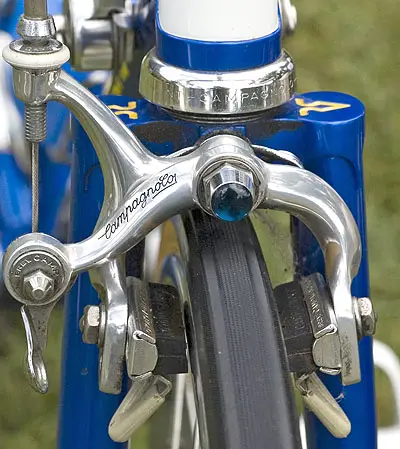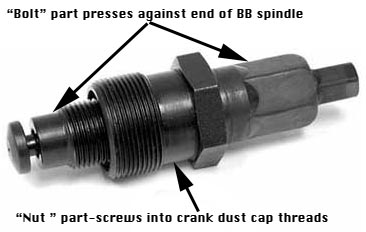Sheldon Brown's
Bicycle Glossary Cn - Cz

|
![]()
See also Jeff del Papa's article on Forging, Casting & CNC Machining on this site.
Most bike parts in current production have some level of CNC finishing. When advertising makes a big deal about it, this is usually an indication that the part concerned is "machined from billet", i.e. that it is entirely sculpted from a big lump of metal. This is actually very much inferior to processes that begin with forging and just use the CNC for the final finishing, because the billet (big lump of metal) will not have the desirable grain structure of a forged part.
An unusual feature of coaster brakes is that this type of rear hub is that it permits the bicycle to be rolled backward without causing the cranks to turn backward as well. This is a useful feature in some freestyle tricks. There is also a type of hub called a "freecoaster" that permits this. It is basically a coaster brake hub with the brake mechanism removed.
 Cobalto ® Brake (Campagnolo)
Cobalto ® Brake (Campagnolo) These date from 1983, Campagnolo's 50th anniversary year.
Originally, "cog" referred to just a single tooth on a "cog wheel." Then "cog wheel" was shortened by popular usage to "cog."
As mountain-bike racing became more organized, mountain bike designs started to morph into a more competition-oriented riding position, with longer top tubes , lower handlebars, narrower saddles, shorter wheelbases and more upright frame angles.
By the late '90s, this trend had gone so far that many casual/beginner cyclists were finding mountain bikes uncomfortable.
In response, the industry came up with what is commonly known as a "comfort bike." Typical comfort bikes resemble mountain bikes in wheel size, brake and gear equipment, but also differ in several ways:
In many respects, the comfort bike harkens back to the riding style/position of the classic English roadster, only with modern gears and brakes.
Comfort bikes are often seen as slower, stodgier versions of "hybrid" bikes, and are targeted at pretty much the same market.
This is a common procedure for aligning and repairing steel bicycle frames. This buzzword sounds more scientific than "bending."
It is a routine procedure for updating older frames to accommodate newer rear wheels that have wider spacing, when upgrading to modern gearing. This is not recommended for frames made of more brittle materials, such as aluminum, titanium or carbon fiber.
![]()
![]()
Compact crank sets usually come with a 50 tooth chainring, and are normally used with an 11 or 12 tooth top sprocket in back.
110 mm B.C.D. double cranks with full-sized chainrings (52-42, 52-40, etc.) were common in the late'70s and early '80s, but they had become nearly extinct for double chainrings. The rebirth of this format, with smaller rings, was pioneered by Tyler Hamilton who used one of these in the 2003 Tour de France
The downside of compact drive is significantly reduced chain life, and decreased interchangeability of parts. I consider compact drive to be a very bad idea for mountain bike use, but it seems to have become ubiquitous.
For mountain bike usage, compact drive typically uses 22/32/42 tooth chainwheels as opposed to the 48-38-28 or 46-36-24 used on earlier mountain bikes.
The original mountain bike cranks were mostly 5-bolt 110 mm/74 mm BCD. "Compact Drive" cranksets usually use the 94 mm/58 mm BCD 5 bolt, or 104 mm/64 mm 4 bolt cranks, as opposed to full-size systems that have 24-28 tooth lows and 46 or 48 tooth highs on 110 mm/74 mm BCD cranks.
"Compact" road frames have sloping top tubes, and are intended to be used with a long seatpost. Compact frames are a little bit lighter than traditional ones, but this is partially offset by the weight of the longer seatpost. Some riders believe these frames are stiffer.
When lines extending forward from the down tube and top tube intersect directly above the front axle, as is usual with a road frame, weight loading only tensions the down tube and compresses the top tube. When the intersection is behind the axle, he frame is better at resisting braking loads. When the intersection is ahead of the axle, the bending loads on these tubes require the front end of the frame to be of stronger construction.
Manufacturers like compact frames because they are more versatile in terms of fit. Usually 3 or 4 sizes are enough to fit 98% of customers. This saves a lot of money for a manufacturer who doesn't need to deal with so many different sizes.
Compressionless housing must not be used with brake cables. It is not strong enough, and can rupture, causing brake failure. See also my article on Cables. 
![]()
![]()

The bottom bracket spindle (axle) used with a standard cotterless crank has tapered square ends, which fit into matching tapered square holes in the cranks. The ends of the axle have either external or internal threading, and a bolt or nut (called the "fixing" bolt/nut) pulls the crank tightly onto the end of the axle.
The nut or bolt head is recessed into the crank, in a hole with threaded sides. These threads can hold a decorative cap that hides the fixing bolt/nut, but their main function it to provide a purchase for the "crank puller", a special tool that is needed to remove the crank from the axle.
See my Tool Tips article on Cotterless Cranks
See also the Bottom Bracket entry in this Glossary. *****
In order to turn left, you start by turning the handlebars to the right for a moment. This moves the front wheel out to the right of the center of gravity, so the bike will start to fall to the left. This is immediately followed by turning the handlebars to the left to cause the bike to remain in balance, which also creates the desired left turn. "Countersteering" refers to the momentary motion of the handlebars in the opposite direction of the desired turn. usually, this is accomplished through the normal slight weave of the bicycle to maintain balance.
Some people, particularly motorcyclists, make a big deal out of this as if countersteering is some special advanced riding technique that you must learn to become an expert bike handler. It isn't. It's just a fancy sounding name for the normal process by which any two-wheeler (or even a unicycle) is controlled.
However, to be ready to swerve quickly out of danger, it is useful to practice quick, forced countersteering so as to initiate a turn as quickly as possible. The amount of countersteering needed decreases as speed increases, and practice will teach you how to approach the limit of traction without exceeding it and skidding out.
See also my article on Braking and Turning
![]()
![]()

For information on interchangeability, see: Bolt Circle Diameter.
This site has an extensive article on cranks.
 Crank Puller, Crank Extractor
Crank Puller, Crank Extractor See also my "Tooltips" article on Cotterless Crank Removal.
See my Tool Tips article on Adjustable Wrenches.
A criterium bicycle will often have a somewhat higher bottom bracket than a road-racing bicycle, to allow pedaling through the turns. (There are a lot of turns in a criterium!) Criterium bicycles are designed with a particular eye to maneuverability, because the peloton in a criterium is likely to be large and dense. Criterium bicycles are not usually built for comfort.
"Crochet" is French for "hook." Evidently somebody at Vredestein got the two languages mixed up.
See also John Allen's article on tandem drivetrains..
![]()
![]()
The upper top tubes and stays are usually curved for a "streamlined" look. Older cruisers usually had a straight lower top tube; later models had cantilever frame designs. Cruisers are built for ride comfort, not efficiency. Classic cruisers were spectacularly heavy, had only one gear, and a coaster brake.
This type of bike is quite impractical for hilly country, due to the weight, the lack of gears, and the low saddle position of older models. For this reason, cruisers traditionally were most popular in very flat places, such as Florida and the southern California coast, and became associated with beach resorts.
As a reaction to the gonzo image of mountain-bike marketing, cruisers seem to be making a comeback in popularity, even in places far from the beach. The new generation of cruisers is much lighter, thanks to modern materials and manufacturers who care about reducing weight. They are also now available with multi-speed gearing. The "neo-cruiser" appeals to aging baby-boomers who have nostalgic memories of the balloon-tire bikes or their youth.
The classic balloon tire bike, before it was known as a "cruiser" was also quite important to the history of cycling because it was in many ways the precursor of the mountain bike.
Another usage for the word "cruiser" refers to an adult-sized BMX bike, typically with 507 mm (24 inch) wheels. See also my article on Singlespeeds.
In a conventional threaded bottom bracket, the cones are part of the bottom bracket axle, and the cups thread into the bottom bracket shell of the frame. The left cup is adjustable, to permit the bearing to be fine tuned. It has a lock ring to secure the adjustment. The right cup is the "fixed cup", usually having a flange that bumps against the edge of the bottom bracket shell when it is screwed all the way in. In the case of hubs and pedals, the cups are part of the hub shell or pedal body, and the cones attach to the axle. One or both of the cones is adjustable, and usually has a locknut and a keyed washer to secure it.
It was very well received by consumers, but delays in production of the special shoes required caused the company to fail. This left the market open to domination by Look, and later Shimano's SPD system and others.
Cyclocross originated as a winter training activity for road racers, and originally was done on retired road bicycles, modified for off road use. Gradually, competitive pressures caused the development of purpose built 'cross bicycles.
Star-wheel cyclometers, such as the Lucas unit, suffered two serious problems. They made an annoying "tink-tink-tink" noise. At high speeds, the star wheel would sometimes turn too far when hit by the fast-moving striker, then, the next time around the striker would hit the tip of one of the star points, sometimes knocking the unit out of position.
The Huret Multito solved these problems by substituting a rubber belt drive in an otherwise similar unit.
With the development of inexpensive electronic cyclecomputers, mechanical cyclometers became obsolete.
![]()
![]()
![]()
Last Updated: by Harriet Fell